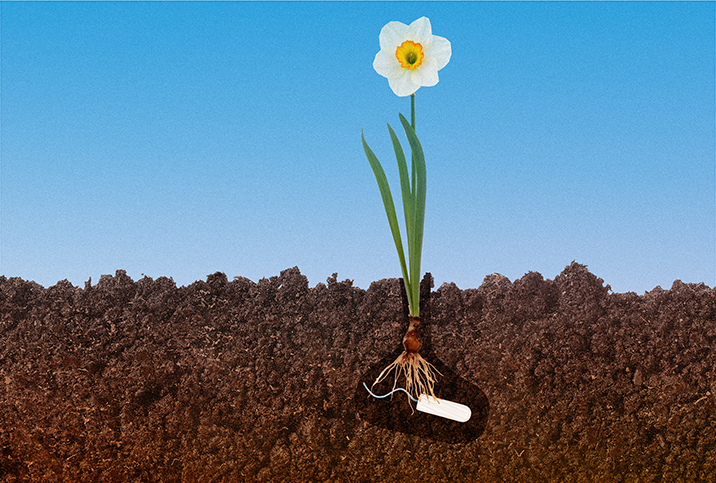Tampons Become the Latest Product Hit by Supply Chain Issues

Product shortages are occurring in multiple sectors in the United States due to supply chain issues, and women seem to be getting hit the hardest. First, we witnessed a baby formula shortage. Now tampons are increasingly difficult to find.
Not to say that women are being specifically targeted. The supply chain problems, exacerbated by the COVID-19 pandemic, caused a run on toilet paper, cleaning products and flour, among other commonly used items. The tampon shortage, though, was somewhat under the radar until recently. While consumers have been discussing the shortage for months, the topic didn't reach a wider spotlight until journalist Alana Semuels wrote about it for Time on June 7, 2022.
“Tucked away on a forum, I found dozens of women complaining about not being able to find tampons,” writes @AlanaSemuels.
— TIME (@TIME) June 10, 2022
“A similar discussion was happening on Reddit, where one poster said she checked eight stores looking for her preferred brand” https://t.co/GDIsLJRZr3
"I feel like the Me Too movement brought attention to some women's issues, but the formula and tampon shortage shows that issues that are women-specific still often fly under the radar as no one in power thinks to make a big deal of them until it is too late," said Sarah Yamaguchi, M.D., a board-certified OB-GYN at DTLA Gynecology in Los Angeles.
"I don't think anyone out there is purposefully letting these shortages happen, but it just falls lower on the priority list," she added. "It's like a mild version of the bystander effect, where people will see something happening and think someone should do something to intervene but they figure someone else will do it."
Why is there a tampon shortage?
The tampon shortage seems to be the result of multiple issues: staffing problems, transportation issues and the rising cost of raw materials.
“Production and, therefore, inventory of these products was impacted due to extensive workforce shortages caused by two separate Omicron surges in the U.S. and Canada in late 2021 and early 2022, respectively,” said Edgewell Personal Care, a tampon manufacturer whose brands include o.b. and Playtex, in a statement to the Hill.
The price of plastic resins and other materials used in tampon production was 9.5 percent higher in April 2022 than one year earlier, according to the U.S. producer price index. In turn, the average price of tampons rose 9.8 percent in a one-year period, according to NielsenIQ's data analysis. All U.S. regions are experiencing the tampon shortage, but Utah and California have been the hardest hit, followed by Minnesota and North Dakota, according to NielsenIQ.
What to do if you can't find tampons
If you go to your usual store and see empty shelves, don't panic. You have other options. The shortage is affecting only tampons right now, so you should be able to pick up your second choice. While tampons might be your go-to period product, consider using pads, period underwear or menstrual cups, Yamaguchi advised. And, hey, you can feel good about going green.
"Period underwear and menstrual cups do have the added benefit of being more environmentally friendly," she said.
Period underwear and menstrual cups typically come at a higher price, although they can be reused for years with proper care. Lower-income individuals may find it difficult or impossible to switch to one of these options. Period poverty—when people with periods struggle to afford necessary menstrual products—rose by 35 percent from 2018 to 2021, according to a study conducted by U by Kotex.
The study also found 38 percent of low-income women reported missing work or school due to a lack of access to period products. If the tampon shortage continues, the results could affect those demographics even further.
If you can't afford a menstrual cup or period underwear, pads are still available at most stores and no pad shortages have been reported. While switching to an alternative option may not be your preferred choice, it's better than reusing tampons or keeping them in too long in order to save them.
Never wear tampons longer than recommended
Tampons are not intended for long-term use. Every four to eight hours, you need to replace your tampon or you risk infection and even death.
"The big danger is using a tampon for too long, as it can cause infection," Yamaguchi said. "Sometimes it's just a mild infection like yeast or BV [bacterial vaginosis], but it can also lead to a life-threatening infection called toxic shock syndrome."
Toxic shock syndrome (TSS) results from a bacterial infection. It is most often caused by the toxins produced by staphylococcus aureus (staph) bacteria or group A streptococcus (strep) bacteria, according to Mayo Clinic. While the condition can affect anyone, it's often associated with tampon use. TSS can cause shock, renal failure and death.
What's being done to address the shortage
CVS told NPR that suppliers have been unable to fill the store's orders in recent weeks, but that they're working with tampon manufacturers to replenish inventory. Tampon companies say they are working overtime to produce more products.
"The Tampax team is producing tampons 24/7 to meet the increased demand," said Procter & Gamble, the makers of Tampax, in a statement to NPR.
The shortage is also drawing the attention of Congress. Sen. Maggie Hassan, D-N.H., has requested tampon manufacturers Edgewell, Procter & Gamble and Kimberly-Clark share their plans for increasing supply and fixing the shortage. Hassan also criticized the tampon price gouging seen on Amazon: One seller listed a box of tampons for $114, as reported by Time.
"Access to menstrual products should be treated like every other essential good," Hassan said in a press release. "At the beginning of the pandemic, price gouging of essentials like toilet paper, cleaning supplies and hand sanitizer was rightly criticized as an exploitation of an emergency for financial gain. Menstrual products should receive that same consideration."


















